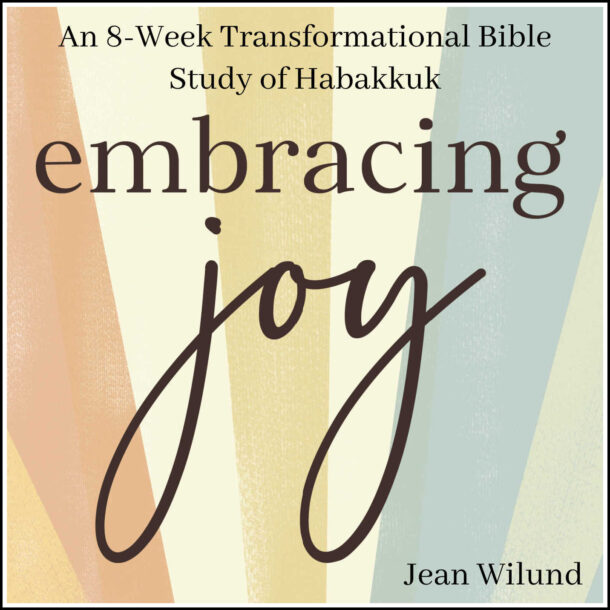Episode 2 Transcript
NOTE: [I inserted time markers into the transcript case you want to fast forward to get a taste of a particular chapter in the book.]
Sometimes the best way to know if we like something is to taste it. Welcome to It’s All About Him!, a fun place to get serious about Bible study. I’m Jean Wilund, your host and the author of Ease Into the Bible, how to wade into the water of God’s Word with confidence. God’s Word tells us to “Taste and see that the Lord is good.”
In today’s episode, I’m going to give you a taste of each chapter of Ease Into the Bible, which is a short and engaging resource I wrote to help you taste and see that God’s Word is the greatest book ever written because it’s the very words of God.
[00:00:42] INTRODUCTION:
Now, let’s get into the details of this book– into its 15 chapters.
Many of the chapters are super short. One reader told me she read the whole book in a day.
Let’s start with a taste for how I opened the book by reading to you the beginning portion of my introduction: My hope for you, Big Wave Bible Competence.
“As forty-foot waves surged into Waimea Bay on the North Shore of Oahu, 40 surfers charged toward them. The 2023 Eddie Aikau Big Wave Invitational drew surfers from around the world to ride what few dared.
“These forty surfers were either insane or confident.
“Assuming they’re all of sound mind, how do big wave surfers gain the confidence to take on 40-foot walls of crushing water? The same way we become confident in surfing the heights and depths of the Bible. They ease into it. They wade in.”
That was the beginning, the opening, of Ease into the Bible.
[00:01:55] CHAPTER 1
In Chapter one, I share another comparison. I compare the Bible to rhubarb. I bet you weren’t expecting this. When the pastor who reviews my manuscripts for theology saw the title to this chapter, he said he had no idea where I was going with this chapter, but he liked it.
Here is a taste of it.
“The Bible is a bit like rhubarb until we understand it. We’re not sure what to do with it.”
Now that really is just a taste of it. I’m not going to go on because guess what? You can read the first two chapters completely on my website. You can download them. Just go to JeanWilund.com.
Look for the “Books” tab. And then click on “Ease into the Bible” in the drop down menu. When you scroll down, you’ll see where you can click on the link to see the whole beginning of the book. In fact, you’ll be able to see, “My Hope For You–Big Wave Bible Confidence,” but also the first two chapters, including Chapter 2, where we look at the Bible’s overarching story, its main point.
[00:03:00] CHAPTER 2
Here’s a taste of this chapter.
“The Bible is one grand and true story.
“All grand stories have a beginning, middle, and end. The beginning sets the stage and introduces the crisis. The middle raises the stakes and reveals how the hero ultimately saves the day. Happy endings bring the longed–for resolution and rest.
“True stories with happy endings are the best.
“So are true heroes.
“Jesus is the greatest and truest hero. His unparalleled story is not a work of fiction or fantasy. It’s historical (and future) fact. Christ’s true story is the gospel told from Genesis to Revelation.”
So this is the beginning of Chapter 2 where we talk about why God gave us the Bible and what it accomplishes in our lives when we read and believe it.
[00:03:48] CHAPTER 3
In Chapter 3, “Understanding the Uniqueness of Jesus,” I answer the question, “Why Jesus?”
Why did Jesus have to come and die for sin? What is so unique about Him?
Here’s a taste of this chapter.
“Throughout Jesus’s life on earth, people called him many things.
“Much true: The Christ. The Messiah. God.
“Much false: A liar. A blasphemer. A servant of Satan.
“God proclaimed exactly who Jesus is. “This is my beloved Son in who I am well pleased.” (Matthew 3:17) on the Mount of Transfiguration, God told Peter, James, and John, “This is my beloved Son. Listen to Him.” (Mark 9:7)
“From Genesis to Revelation, the Bible reveals:
Jesus Christ is the uncreated and eternal sinless Son of God. The visible image of our invisible God.”.
That is just a taste of Chapter 3.
[00:05:00] CHAPTER 4
In Chapter 4, “Why We Can trust the Bible,” I answer the question of how we can know that we can truly trust the Bible. So let me read from this chapter.
“The Bible opens with God speaking the world into existence.
“Let there be light.”
“The Bible ends with a new world that doesn’t need the light of a lamp or even the sun. God’s glory will fill His kingdom with His light.
“Some may read these accounts and dismiss the Bible as a fairy tale, especially when they discover the Bible also includes a talking donkey, a virgin birth, and a man walking on water.
“With such stories, how can we trust the Bible, much less submit ourselves to it as the authority over our lives? How can we know it’s God’s Word, not a product of the imaginations of men?
“These reasonable questions have been answered in thick books. This small book will only touch on the abundance of evidence.”
This was a small taste of Chapter 4, why we can trust the Bible. And then we go on and we look at the testimony of Christ, His words and resurrection, and the testimony throughout history. Numerous archaeological artifacts that support the Bible’s testimony.
We also consider logical reasoning and the final stumbling block to trusting the Bible.
[00:06:30] CHAPTER 5
Chapter 5 gives us a look at the authors. Who wrote the Bible? What do we know about them? How did the Holy Spirit direct them as they wrote?
And what about the anonymous authors, the unnamed authors? If we don’t know who they are, how can we trust them? I answer this and many other questions. Here’s a taste of this chapter.
“In the beginning, God” (Genesis 1:1).
“The Bible’s ultimate Author is our perfect God. But He chose to write through imperfect men. The melting pot of biblical authors includes a Hebrew Egyptian prince who became a murderer, then a shepherd, and ultimately the leader of a wandering nation (Moses). ()
“The list of authors also includes a former hater of Christ and persecutor of Christians named Saul. After Jesus blinded Saul on a road, he embraced the truth of the gospel, began using his Roman name Paul, and became one of the greatest Christian leaders in history.”
[00:07:36] CHAPTER 6
Chapter 6 covers how God gave us the 66 books of the Bible. How did the Bible we hold in our hands come together?
Here’s a small taste from this chapter, starting in the second paragraph.
“The Canon of Scripture
“Before the first author penned the first words in the Bible, God had already chosen which books would become the Holy Bible, which would be the canon, or, as the original Greek word defines canon, ‘the measuring rod, rule, and standard for the Holy Scriptures.’
“Just as stamping an artist’s name on a painting doesn’t make it authentic, stamping God’s name onto an ancient text doesn’t make it God’s authoritative Word. For the people of God to submit themselves to a book’s commands and teachings, it had to bear its Creator’s unique “fingerprints,” His obvious traits.
“It’s important for us to understand that the canon of scripture we have today, the 66 books of our Bible, weren’t chosen. Each book was recognized as displaying the obvious traits of the Author—God.
[00:08:38] CHAPTER 7
Chapter 7 discusses a question that baffled me for a long time. How is the Bible organized? If you’ve tried to read it in order from Genesis to Revelation, it goes along nicely in chronological order, and then suddenly it just doesn’t.
It’s so confusing, but when we understand how the Bible is organized, it suddenly all makes sense. So let me just read a taste from the very beginning of this chapter.
Understanding How the Bible is Organized.
“If I handed you a book, where would you start reading? What if I handed you a Bible?
“The Bible is a book of 66 books split into two divisions—two Testaments.
“The first division—the Old Testament—has 39 books.
“The second division—the New Testament—has 27 books.
“Again, where would you start reading? In the Old Testament? The New Testament? Why do we even have two Testaments? And what is a Testament?”
[00:09:41] CHAPTER 8
In the next chapter, Chapter 8, I give you the chronological order of the books of the Bible as best as possible according to when the recorded events happened.
Let me give you a taste of the very beginning of Chapter 8.
“The Bible happened in real time in real history. But, as we saw in the last chapter, the Bible isn’t organized based on its historical timeline. If you ever tried to read straight through the Bible, you likely discovered this after Judges.
“A true chronological reading of the Bible is complicated. It’s hard to place a modern date on ancient history. The Bible writers kept time differently than we do. We mark time based on Christ’s birth. This wasn’t possible for the Old Testament writers, and it didn’t become the standard until several hundred years after the Bible was compiled.”
This was just a taste of Chapter 8, and it goes on and includes a list of the most basic chronological order of the books of the Bible.
[00:10:41] CHAPTER 9
Now, in Chapter 9, we’re going to discuss the best—and the worst—Bible reading plans. Let me give you a taste.
“Which is more important—reading the Bible or studying the Bible?
“Neither. Neither is more important because both are vital.
“When we read the Bible, we take it in like we would a letter or novel. We let the author speak to us, the words wash over us, and the whole message sink into our soul.
“When we study the Bible, we dig into it like we would a treasure hunt. Not everything of value sits in plain sight. Some of its greatest treasures wait for those willing to dig to find it.
“In this chapter, we’ll look at the first step toward mining the immeasurable treasures in God’s Word—reading the Bible.
“The whole Bible.”
Okay. So that’s just a taste of Chapter nine. I’m also going to share in this chapter, four Bible reading commitments that I recommend, and I discuss why I highly recommend following a Bible reading plan, and then give you what I consider to be the two worst Bible reading plans, and two of the best reading plans.
[00:11:54] CHAPTER 10
In Chapter 10, I answer the question, “Which Bible translation is best for me?” I help you understand the difference between the translations and which translation works best for each need that you may have. Now here’s a taste from this chapter.
“I once heard a speaker say we should only read the original Bible. The King James Bible.
“I was so confused.
“English wasn’t a language when the Old and New Testament were written. The King James is not the original. But I agree, we should read a Bible as close to the original manuscripts as possible, as long as we can understand it.
“Do you understand Greek or Hebrew?
“If not, thank the next Bible translator you meet for his or her part in providing us with a wealth of translations of God’s Word.
“Which is the best translation for us?
“Does it even matter which translation we read as long as we’re reading a Bible?
“Actually, translations matter a great deal.”
[00:12:56] CHAPTER 11
Now, Chapter 11. Along with the chapters on the overarching story of the Bible and the uniqueness of Christ, Chapter 11 is one of the most important chapters. We look at the Transformational Bible Study Method, an easy and effective way to study the Bible—and it leads to authentic transformation.
So let me read the very beginning of this chapter.
“God’s word never changes, never fails, and never becomes irrelevant because it’s eternal truth. Contrary to popular opinion, we don’t each have our own truth. We have beliefs we think are true, but our beliefs are only true if they agree with the Truth—with the Word of God. Truth never changes because Truth is a person—our unchangeable, immutable Lord, Jesus Christ.
“I am the way. And the truth and the life.” (John 14:6)
“The Transformational Bible Study Method is an easy and effective way to study the Bible because it leads us to correctly understand the truth and rightly respond to it using three simple questions.”
And I get into those three questions and the three steps, the three easy steps in this chapter.
[00:14:12] CHAPTER 12
Chapter 12 may surprise you a little and answer a question you may have wondered about. What exactly is biblical doctrine and is it a straitjacket or a life vest?
Let me read from the beginning of Chapter 12.
“The first time I met with my mentor, Grace, she said, ‘Sit down, Jean, we’re going to study doctrine.’
“Images flashed through my mind of dusty old books filled with words like propitiationand imputation. I groaned—inwardly, of course. I didn’t want her to know I was already bored.
“The word doctrine sounded like a straitjacket, designed to hold me in bondage to outdated beliefs no longer relevant to today’s Christianity.
“I’d asked Grace to meet with me because I wanted to love God and His Word more, not study doctrine or other stifling religious trappings.
“Then I learned the truth: Doctrine is desirable and inescapable for Christians.
“Doctrine is desirable because it encapsulates the teachings and principles of the Bible that direct our lives and mature us (Eph. 4:14–16).
“Doctrine is inescapable because anyone who knows about the Bible holds beliefs about what it teaches—about its doctrines—even if they can’t put a name to them (like regeneration or justification). As Christians, our concern is to know whether the doctrines we already believe (knowingly or unknowingly) are true or false.”
That was just a taste of Chapter 12.
[00:15:41] CHAPTER 13
Now, Chapter 13 tackles a topic I think our modern day church needs more than ever: Why church matters. A staggering number of Christians are staying home to watch church online. So in Chapter 13, we look at what Scripture says about the church and why it matters.
And I’ll even help you learn how to find a good local church. So let me read from the very beginning of this chapter.
“If I have a Bible, do I need the church?
“Yes.
“How’s that for a simple answer?
“Our next question requires a fuller answer.
“Why do we need the church?
“Before we talk about why we need the church, let’s first define what we mean by the church.”
So I go on to explain what exactly is the church? What does the Bible mean when it talks about the church? And what do we mean when we talk about the visible and invisible church? What are the characteristics of a faithful church? And also, I have a section on what if you can’t find a faithful church? What do you do then?
[00:16:52] CHAPTER 14
Chapter 14 covers helpful Bible study tools and resources. Let me give you a taste from this chapter.
“If you’re a Christian on a deserted island with only the text of the Bible—no cross-references, commentaries, or study notes—you have all you need to understand God’s Word. The Holy Spirit doesn’t need tools. He’s able to teach us everything God wants us to know. But, if you’re not on a deserted island, there’s nothing wrong with using available tools and resources.
“Before we look at the wealth of tools, let’s first consider an important principle to follow when using biblical resources.”
I end the chapter with an example of how to use some of these resources.
[00:17:41] CHAPTER 15
Chapter 15 is our last chapter, and it dips our toes into each book of the Bible with a short Christ-centered summary of each book.
I’ll just give you a short taste at the very beginning of this chapter.
“To dive in and fully explain the treasures in each book of the Bible would take a book at least the size of the Bible. I only have one chapter. Rather than dive in headfirst, we’ll merely dip our toes into the Bible’s 66 books.”
This brings us to the end of the book. Chapter 15 is our final chapter. I do have a little additional information and encouragement at the end, but Chapter 15—after we dip our toes into every book of the Bible—your feet are firmly planted in the water of God’s love.
[00:18:34] FUTURE EPISODES OF SEASON 3
In the next episodes, we’ll start going through the topics covered in this book more thoroughly. I’ll add additional information, take us a little deeper than this book is designed to do, and I’m going to answer the questions that I get back from my readers as the book launches.
If you have any questions you want me to address, as you read through this book, contact me through my website, and I will be glad to answer your questions in maybe one of the very next episodes.






